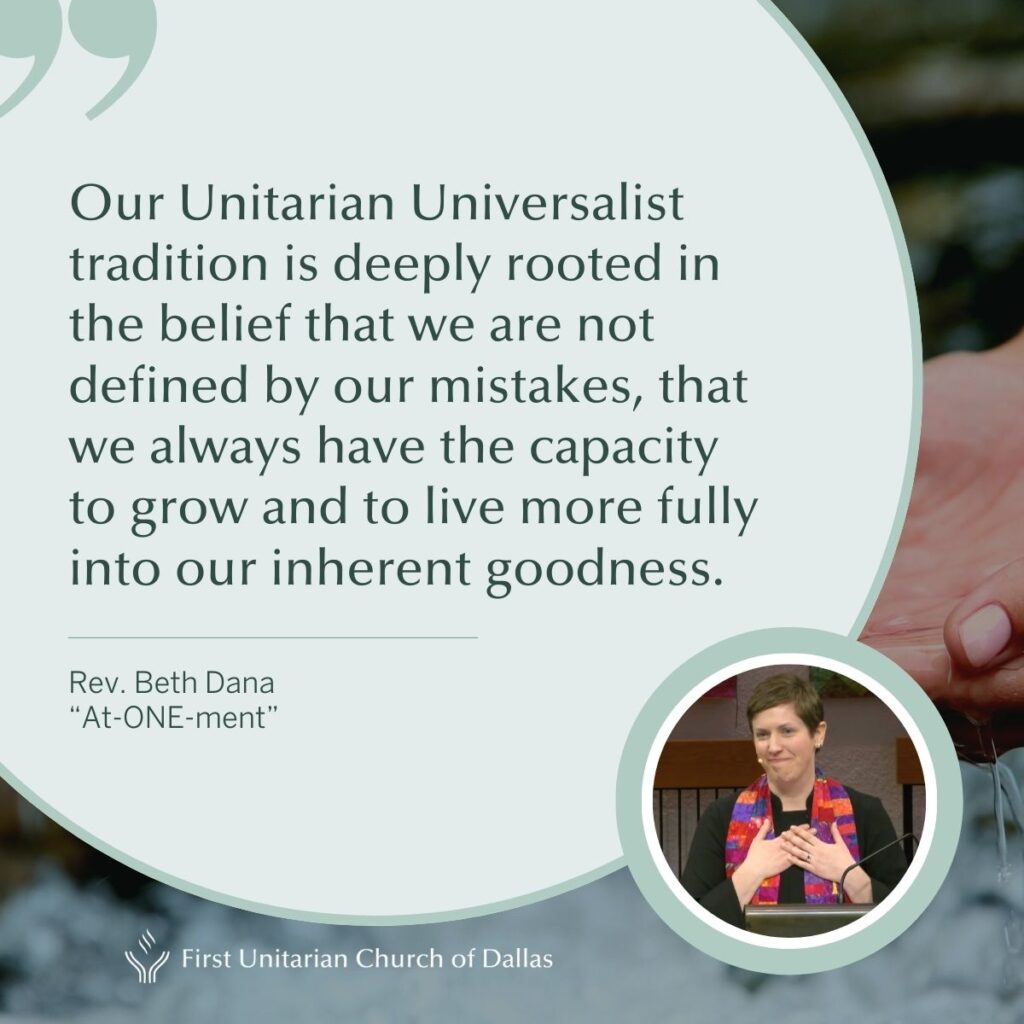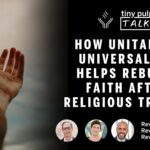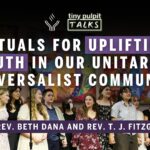At-ONE-ment | Rev. Beth Dana | 10.22.23

In the third sermon in our Rituals That Ground Us series, we explore atonement. Rituals of repentance, repair, and atonement are radical in the context of our unapologetic world. What do these rituals look like for us as Unitarian Universalists and how do they ground us?
Sermon Transcript
Yo-Yo Ma, a world renowned cellist considered a child prodigy from an age of five and Julia Child, the queen of food television long before the days of food network celebrity chefs, are both considered virtuosos in their fields and they have a similar approach to making mistakes. When Yo-Yo Ma makes a mistake while performing, he says that he thinks about how Julia Child reacted when she aired in the kitchen. “Oh, the chicken’s fallen on the floor. Yes. Oh, we’ll pick it up and just put it right back.”
And you know what he says? “Everybody’s with you because a musical performance, just like preparing a meal, has a greater purpose.” We are communing together. “It’s not about proving something,” he says. “It’s about sharing something.” You and I, we all share this hour of worship, this life, this world, the health and wholeness of each of us and of the whole are interdependent, which is why it’s so essential that we attend to mistakes, to hurtful words and actions both big and small.
The Level Analogy
Now, for those of you who are visual learners, I present to you a level, a common tool used in construction for making sure that structures are level and balanced. When something’s level and balanced, the little bubble in the center is in the center in between these two little lines. But when it’s off balance, the little bubble moves to whichever side is higher. So imagine me on this side of the level and you on the other, I said or did something that hurt you, and so you are weighed down by the hurt and resentment. But the bubble rises to my side and I’m in my own little bubble, isolated from your hurt and resentment. But if I’m aware of what I did, I may also be weighed down with regret or guilt, and the bubble then rises to your side and you’re in a bubble of hurt, isolated from my regret and guilt or from my desire to make things right. “It’s about sharing something,” Yo-Yo Ma said. The level itself is the relationship, the community, the world that we share. So how do we get back into balance?
Today in our worship series on rituals that ground us, we are exploring rituals of atonement, rituals that bring about the healing and repair of relationships. Now, I’m sure that each of us can think of relationships in our lives that could use some healing. Maybe it’s a family member we haven’t talked to in a long time because we don’t want to face our differences or because of hurt that lingers from an interaction years ago. Or the friend with whom we had a falling out and never really sought repair. Or the small group we’re a part of where we said something harmful that was experienced as a microaggression, our words obviously shut another group member down and we know this, but we never addressed it directly. Or maybe it’s the child or spouse whom we yelled at in a moment of stress and frustration, never apologizing or coming back to the conversation. All of these kinds of things throw off the balance.
Distinguishing Between Intent and Impact
Sometimes the harm exists not just directly person to person, but on a cultural level. In 2008, pregnant with her first child, Jenna Karvunidis created the first ever recorded gender reveal party. She wrote about it on her blog with pictures of the pink cake revealing the sex of her fetus. Her blog post and the trend of gender reveal parties took off, making a cultural impact far beyond what she had ever imagined. 11 years later, she wrote another very public blog post expressing her regret. She saw both the immediate material harm that was sometimes caused by outrageous reveals that led to literally wildfires, exploding cars and more. But even more so, she felt regret about placing even more cultural emphasis on the sex assigned to a baby at birth, or in many cases, even before birth. Her own child celebrated with the pink cake, grew up and did not conform to a strict gender binary. Karvunidis realized the immense harm that these reveals had on transgender, non-binary, and intersex kids, and the way that they limited the gender expression of cisgender kids.
I think this story is the perfect illustration of the distinction, important distinction between intent and impact. Karvunidis had experienced several miscarriages and was ecstatic to celebrate that her pregnancy had developed to the point where the doctors could discern the anatomy of the fetus. Her intent was good, she meant well, and the expression of her intent was steeped in ways of thinking that she hadn’t yet examined, but that doesn’t mean that the outcome can be excused. She acknowledged and specifically named the harm that she had caused with this trend, expressed deep regret and pleaded for people to stop staging these events. Some people have spoken out saying that she needs to do more to repair the harm done and to prevent further harm of this kind. The cultural process of repair is in many ways, much, much harder than healing the relationship between two people. This is why the legacies of whole nations like the genocide of Indigenous peoples in the Americas and the legacy of slavery are so challenging to truly repair and atone for.
As our reading for today reminds us, atonement is about turning and returning to ourselves and each other, to the earth and our rhythms, to this moment, to our deepest desires and knowing, to trusting ourselves and each other. It kind of reminds me of the Shaker song, Simple Gifts, which ends with, “To turn, turn will be our delight till by turning, turning we come round right.” Many religious traditions have stories of wayward children finding their way home, of turning and returning to who they are and where they come from. There’s a medieval Jewish allegory about the child of a ruler who had gone astray for 100 days, and the child’s friends kept telling them, “Return to your parent,” and the child said, “I can’t.” Then the ruler sent a message to their child saying, “Return as far as you can, and I will come the rest of the way to you.” In a similar way says the story, God says, “Return to me and I will return to you.”
Sometimes we just need the courage to begin and to go as far as we can, and then the ruler, the parent, the friend, the community, the divine will return to meet us. “Return us, turn us, and we will dance and be held and behold that we are whole and be in harmony with you,” says the reading.
The Four Themes of Atonement
Just as stories of wayward children exist in many religious traditions, similar processes of repentance, repair, and atonement have evolved from many different times and places. Rabbi Danya Ruttenberg in her recent book, On Repentance And Repair: Making Amends in an Unapologetic World points out that these processes share some common themes.
The first theme is confession. The offender faces and owns the harm that they’ve created.
The second theme is transformation, doing the work to become different in order to not cause the same harm again.
Maimonides, the medieval Jewish philosopher said that, “Someone who can confesses sins but has not abandoned sin in their heart is like someone who becomes immersed in the ritual bath while holding a lizard.” Ruttenberg translates Maimonides’ idea saying, “The living waters cannot purify as intended if someone is clutching a non-kosher creepy crawley that will invalidate the whole process.” The point is confession without transformation goes nowhere. Whatever harm we’ve caused, it does not define us. We have free will and we can always choose to change how we live going forward. Our Unitarian Universalist tradition is deeply rooted in this belief that we are not defined by our mistakes, that we always have the capacity to grow and to live more fully into our inherent goodness. The sins of our finite lives are not infinite.
The third theme and processes of atonement is apology, making things right with those who were hurt concretely through amends and emotionally through apology.
And finally, the fourth theme is making different choices, living out those commitments to transforming in the real world. What strikes me about this process is that it’s so much more than person causes harm, person says sorry, other person forgives, and all live happily ever after. Transformation is an essential part of the process and it requires deep internal work without which true apology and forgiveness and atonement are impossible.
Ruttenberg says, “The holy atonement reset button doesn’t work until we’ve cleaned up our own mess.” She expands on this, reminding us that forgiveness is also not a given. “A person can do real profound comprehensive repentance work,” she says. “And even get right with God, experience atonement even if their victim never forgives them.” Repentance, forgiveness and atonement are separate processes. Religious traditions typically understand atonement as getting right with and harmonizing ourselves with God, a separate but related process to getting right with other people.
“Getting Right with God” as Unitarian Universalists
So this leads to some questions you may be asking yourself. How do we as Unitarian Universalists get right with God? How do we heal our relationship with the holy mystery of which we are a part, especially when we all experience this mystery so differently? And if humans aren’t inherently sinful as we believe, but are inherently good, do we need to heal our relationship with the God of our understanding? These are good and important questions.
Hosea Ballou, the great Universalist preacher was one of our early forebearers who took on these matters. In 1805, he wrote a treatise on atonement. His very, very long subtitle was, “In which the finite nature of sin is argued, its cause and consequence as such, the necessity and nature of atonement and its glorious consequences in the final reconciliation of all people to holiness and happiness.” He rejected the theology of substitutionary atonement, which held that Jesus’s death atoned for humanity’s sins. “God is not dissatisfied with us,” he said. “Because humanity is not inherently sinful and in need of redemption.”
Ballou insisted that salvation is universal. He claimed that, “God’s love is expansive and eternal, not conditional. And when humanity realizes this, life on Earth will be transformed and there will be final reconciliation of all people to holiness and happiness.” Ballou’s answer to the question of how we get right with God is to accept and live as if there is a love greater than any one of us that holds us all, which brings about healing and wholeness in our world if we tap into it and help make it so.
The Role of Covenant
Our Unitarian Universalist rituals of atonement are practiced through covenant, the covenants we inherit, the covenants we build together, and the covenants that we stray from and return to again and again throughout our lives and community. The larger society in which we live is not very good at doing the work of repentance and repair. So the practice of covenant is counter-cultural. It requires humility, intention, curiosity and care.
Unitarian Universalist minister Rebecca Parker says, “We inherit covenant before we create covenant. We do not make ourselves. We are given the gift of life, the gift of the earth that sustains life, and the gift of one another here now and in all generations leading up to now. We are born into relationship before we shape relationships by our conscious intention,” she says. So when we stray from these covenants, we’re losing connection with our communal context, with the relationships of which we are a part, that go beyond our more immediate and direct ties.
Judge Joseph Flies-Away, a former Chief Judge for the Hualapai Tribal Court in Arizona says that, “The people who appeared in his court acted like they had no relatives.” He saw his role as a judge as reconnecting them to those inherited relationships, a process of accountability rather than punishment. Punishment comes from the outside and rarely leads to real change or transformation. But accountability is about doing the work from within, the kind of work that Maimonides and many others have promoted through processes of atonement.
We Unitarian Universalists create covenant too everywhere we go. Whenever we gather for the first time as a group or for a class, we create a covenant. Even our youngest children in the church are learning this practice of making promises to one another about how they will interact with their peers and with adults. Our church staff have a covenant and your ministry team, Daniel, T. J., and I have a covenant, articulating our commitments to one another in service to this church and the world.
Covenant is challenging because it’s not just a set of rules that if you follow, you’re in and if you break, you’re out. It’s a living agreement, a set of promises that we hold ourselves and each other to which calls us to the hard work of repentance, repair, and atonement when individuals or the collective break those promises. Being part of a covenantal community invites us into a ritual of courage, integrity, and communal care. It’s not always comfortable or easy, but it’s important because it’s how we maintain right relationship with ourselves, with each other, and with the holy. It’s how we build beloved community here on Earth. Covenant uses the practice of calling in rather than calling out, to seek repair and rebalancing when harm or imbalance occurs.
Calling Out vs. Calling In
Now, I know there’s a big public debate about calling in versus calling out, and I will say calling out has its place. It’s a public rebuke, often online these days, confronting someone and holding them accountable, often speaking truth to power. Black feminist Loretta Ross says, “Call outs are justified to challenge provocateurs who deliberately hurt others or for powerful people beyond our reach.” The original meaning of to call out before it became a phenomenon on social media was to challenge someone to a dual. So the implication is that you’re asking for a fight. This has its place, especially when victims and witnesses need to hear someone name the harm.
But the practice of calling in is a little different. Calling in originated with queer, Vietnamese disabled writer, Ngọc Loan Trần, who describes it as, “A practice of loving each other enough to allow each other to make mistakes and then to let them know in a gentle, often private way that they have aired.” Calling in tends to be practiced where there are preexisting relationships or a shared communities such as in covenantal communities like ours.
I know and have felt in my gut how hard it is to practice covenant again and again in my life as a Unitarian Universalist. The first time I remember grappling with this was in high school. I served on the youth adult committee for our district. And when we gathered for youth conferences, a small subset of the committee was responsible for responding to covenant issues that arose over the course of the weekend and helping people to repair those relationships and restore covenant. And one of these conferences, a girl reported that a boy was making her uncomfortable, physically encroaching on her space and not responding to her attempts to get him to stop. His dad happened to be at the event as an adult advisor, and we learned from him that his son was neurodivergent, sometimes had trouble understanding appropriate physical boundaries and social cues. After conversations with the boy and the girl and between the boy and his dad, the decision was ultimately made to ask him to leave the conference.
The impact of his actions, while not meant to cause discomfort or harm, necessitated some time away to more fully understand his impact and to learn how to engage differently next time. I too have been in the position of hurting others, saying something that had an impact that I didn’t anticipate and being called back into community to learn and change. And in none of these situations was the person banned or shunned. We were invited into a period of learning and growth and repair of relationships after which we returned to the group or the community. I’ve helped facilitate similar processes with young people in this church, resulting in them returning to their group after a period of inner work and relational repair. And it included all the common themes of atonement processes across time and place. Confession, transformation, amends, an apology and making different choices.
Practicing covenant is a ritual done in community. It’s not about any one individual really, but about how the community as a whole is living it out. Some groups revisit their covenant at the beginning of every gathering, kind of like we do with our affirmation here in worship, and they end their time together with a checkout that includes some honest reflection on how they did as a group. How did they or did they not honor their covenant during their time together? And what can they do differently next time? The care that is woven into these processes is part of what makes me proud to be a Unitarian Universalist. In how many other places can you imagine something like this happening? Not many. I really believe that our world would be a better place if more communities adopted this practice.
Danya Ruttenberg says, of the work of repentance and atonement, “While we can’t undo the past, we can address the present with integrity and endeavor to create a future that is much more whole than anything we can imagine from here.” So my hope for you today is that you will find in this practice, something that grounds you in the present and points you toward a better more whole future. It’s a daily practice because we all make little mistakes and miss the mark all over the place. We are imperfect, but this imperfection does not mean that we are a lost cause. There is always the possibility of return, of repair, of healing. In the words of Yo-Yo Ma, “It’s not about proving anything. It’s about sharing something.” So we’re with you.
The Ritual of Forgiveness
We’re going to close our service today by engaging in a ritual of forgiveness. I think there is wisdom in the saying that the words I forgive are the first step toward actually doing so, and so we will say and sing collectively, we forgive ourselves and each other, we begin again in love. Forgiving ourselves and each other is the first and second step. Forgiveness is human, but grace and atonement are divine. Atonement is returning again to the love that we are born from, in and with. Restoring harmony with self and other, allowing us to grow in harmony with the divine. As we sing these words together, we may feel twinges of remorse, but let us also feel joy at the moments, the memories of moments of love and right doing and the ever present hope of healing.








